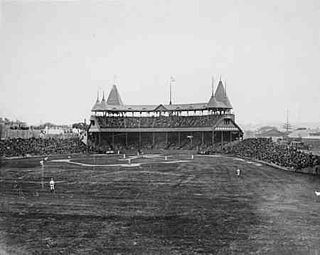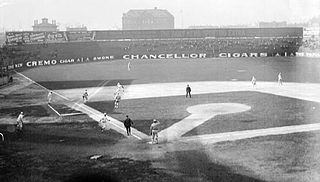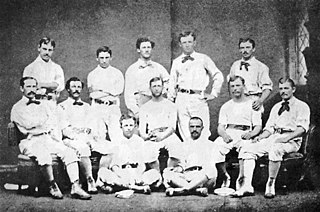The National Association of Professional Base Ball Players (NAPBBP), often known simply as the National Association (NA), was the first fully-professional sports league in baseball. The NA was founded in 1871 and continued through the 1875 season. It succeeded and incorporated several professional clubs from the previous National Association of Base Ball Players (NABBP) of 1857–1870, sometimes called "the amateur Association". In turn, several NA clubs created the succeeding National League of Professional Baseball Clubs, which joined with the American League of Professional Base Ball Clubs to form Major League Baseball (MLB) in 1903.

South End Grounds refers to any one of three baseball parks on one site in Boston, Massachusetts. They were home to the franchise that eventually became known as the Boston Braves, first in the National Association and later in the National League, from 1871 through part of the 1914 season. That stretch of 43 1/2 seasons is still the longest tenure of the Braves club at any of their various ballparks and cities since 1914.

South Side Park was the name used for three different baseball parks that formerly stood in Chicago, Illinois, at different times, and whose sites were all just a few blocks away from each other.

Worcester Agricultural Fairgrounds was a 20-acre (8.1 ha) site in Worcester, Massachusetts, in the 19th century. The grounds are mainly known for having hosted the Worcester Worcesters, a professional baseball team of the National League from 1880 to 1882. As a major-league ballpark, the site is usually referred to as Agricultural County Fair Grounds or Worcester Driving Park.
Jefferson Street Grounds was a baseball field located in Philadelphia, Pennsylvania. It was also known as Jefferson Park and Athletics Park. It was home to three different professional baseball teams, competing in three different leagues. Notably, it was the venue for the first game in National League history, played on April 22, 1876.
Union Grounds was a baseball park located in the Williamsburg section of Brooklyn, New York. The grounds opened in 1862, its inaugural match being played on May 15. It was the first baseball park enclosed entirely by a fence, thereby allowing proprietor William Cammeyer or his tenant to charge admission. This permitted paying customers to watch the games from benches in a stand while non-paying spectators could only watch from embankments outside the grounds.

Red Stocking Base-Ball Park was a baseball grounds in St. Louis, Missouri. It was home to the St. Louis Red Stockings of the National Association (NA) during the 1875 season, so it is considered a major league ballpark by those who count the NA as a major league.
Union Base-Ball Grounds was a baseball park located in Chicago. The park was "very visibly downtown", its small block bounded on the west by Michigan Avenue, on the north by Randolph Street, and on the east by railroad tracks and the lake shore, which was then much closer than it is today. The site is now part of Millennium Park.

West Side Park was the name used for two different ballparks that formerly stood in Chicago, Illinois. They were both home fields of the team now known as the Chicago Cubs of the National League. Both ballparks hosted baseball championships. The latter of the two parks, where the franchise played for nearly a quarter century, was the home of the first two world champion Cubs teams, the team that posted the best winning percentage in Major League Baseball history and won the most games in National League history (1906), the only cross-town World Series in Chicago (1906), and the immortalized Tinker to Evers to Chance double-play combo. Both ballparks were primarily constructed of wood.

Recreation Park was a baseball park in Philadelphia.

The Athletic Base Ball Club of Philadelphia was a prominent National Association, and later National League, professional baseball team that played in the second half of the 19th century.
The Capitoline Grounds, also known as Capitoline Skating Lake and Base Ball Ground, was a baseball park located in Brooklyn, New York, from 1864 to 1880. It was built to rival nearby Union Grounds, also in Brooklyn. The park hosted local amateur teams in its early history, but later hosted professional and semi-professional games. The park's only season as the home field for an all-professional team occurred in 1872 when the Brooklyn Atlantics joined the National Association of Professional Base Ball Players. The park was flooded during the winter and used as an ice skating park. The grounds were used by local high schools and colleges as well, to play American football games, and ice rink football matches.
The Washington Nationals of the 1870s were the first important baseball club in the capital city of the United States. They competed briefly in the National Association of Professional Base Ball Players, the first fully-professional sports league in baseball. The Nationals are considered a major-league team by those who count the National Association as a major league. Several other baseball clubs based in Washington, D.C., have also used the historic name Nationals.
The Lincoln Park Grounds, commonly known as Union Grounds, was a former baseball park, part of Lincoln Park, located in Cincinnati, Ohio. The Grounds were built for the Union Cricket Club in 1856; they "were used for cricket and baseball in the summer and were flooded for skating in the winter." In 1865 Harry Wright became the professional of the Cincinnati Cricket Club, which also used the grounds, and the next year Aaron Champion, president of the new Cincinnati Base Ball Club, "approached Wright to propose a limited use of the grounds if the CBBC and Live Oaks club would put in $2000 each to revamp the Lincoln Park Grounds."
A year later the [Red Stockings] leased the grounds of the Union Cricket Club for its home tilts. Most club members referred to the field as the Union Grounds, although it also was known as the Union Cricket Club Grounds and the Lincoln Park Grounds, given the fact that the eight-acre, fenced grounds were located in a small park behind Lincoln Park in Cincinnati, near the Union Terminal. It was a twenty-minute ride by streetcar to the Union Grounds from the heart of downtown Cincinnati. Aaron Champion ordered that approximately $10,000 worth of improvements be made to the home grounds for the 1867 season, including grading and sodding of the field and building of a new clubhouse and stands.

Charles Hodes was an American professional baseball player who played as a catcher, infielder, and outfielder in the National Association for three seasons from 1871 to 1874. A Brooklyn native, Hodes played one season each for the Chicago White Stockings, Troy Haymakers, and Brooklyn Atlantics. He had a career batting average of .231 in 63 total games before dying from tuberculosis in 1875.
Rovers Football Club was a 19th-century football club based in Glasgow.








